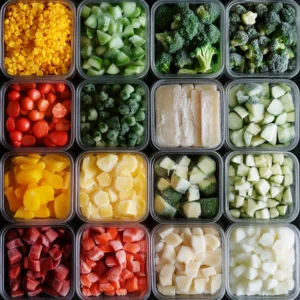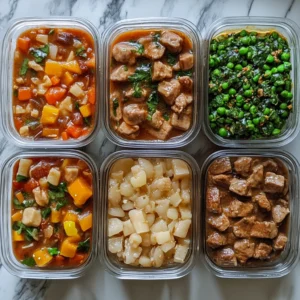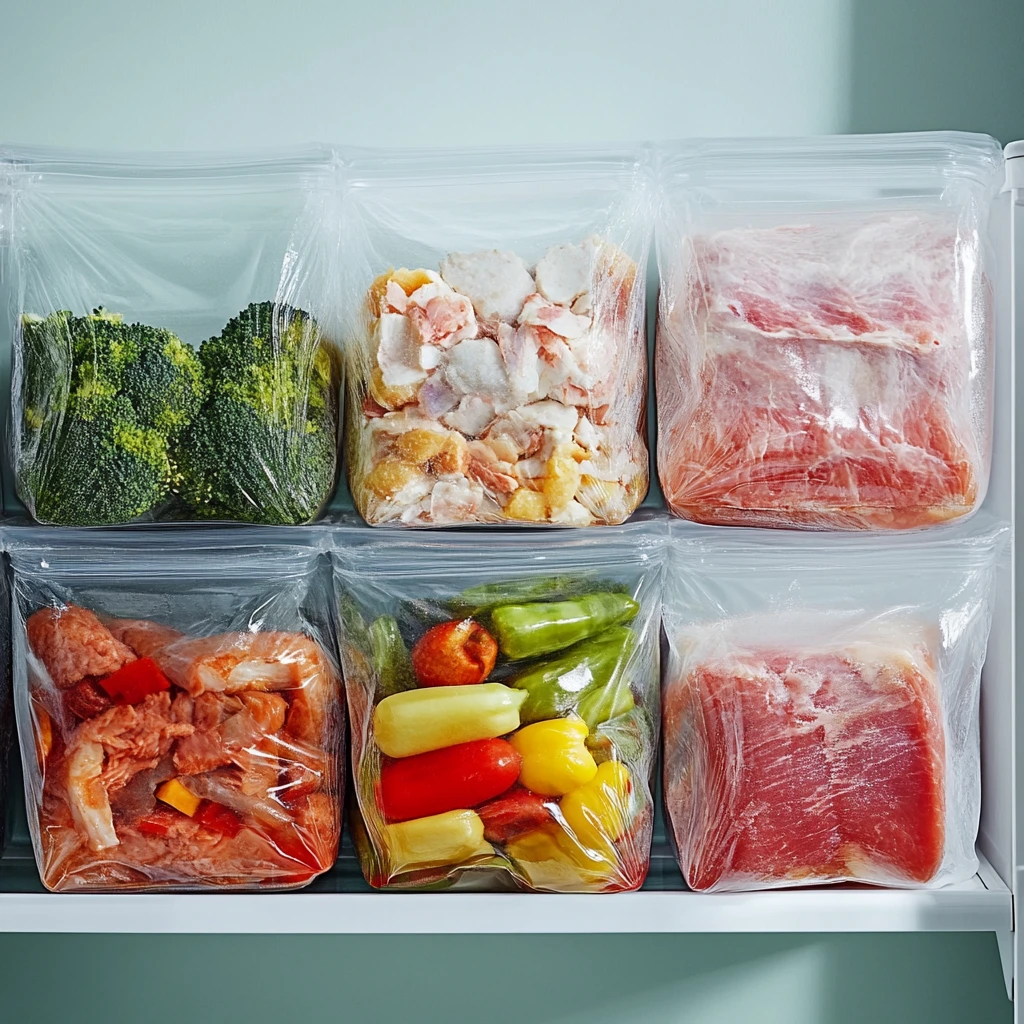Storing your food in the freezer is a practical way to reduce waste, preserve nutrients, and maintain food safety. In this comprehensive guide, we dive into the science behind freezing, explore the advantages and limitations of this method, and provide detailed storage durations for various food categories.
Whether you’re a seasoned cook or just beginning to explore meal prep, understanding freezer storage durations is essential for maintaining the quality and taste of your ingredients.
Introduction
Freezing is one of the most effective ways to extend the shelf life of perishable food. In this article, we explain how long to keep food in the freezer, providing expert insights into safe storage practices and practical tips for everyday use.
- Why Freezing Matters:
- Food safety: Reducing the risk of spoilage and bacterial growth.
- Nutrient preservation: Maintaining essential vitamins and minerals.
- Convenience: Enabling meal prep and reducing the frequency of grocery shopping.
- Scope of the Article:
- The science and fundamentals behind freezing.
- Detailed storage times for meats, vegetables, dairy, and more.
- Best practices to prevent freezer burn and maintain quality.
- Frequently asked questions addressing common concerns.
Before diving into specific storage durations, take a moment to explore some of our related recipes that can inspire you to make the most out of your frozen ingredients. For instance, discover a hearty Onion Potato Casserole Recipe perfect for a cozy meal, or indulge in the sweet flavors of our Vermont Maple Syrup: A Sweet Tradition.
The Fundamentals of Freezing

Understanding the freezing process is key to optimizing freezer storage durations and ensuring that your food retains its flavor and nutritional value.
- What is Freezing?
Freezing is a method of preservation that involves lowering the temperature of food to slow down enzyme activity and microbial growth. This process:- Preserves the structure and nutritional content.
- Helps maintain the texture of the food when done correctly.
- How Freezers Work:
Modern freezers use advanced cooling technology to maintain temperatures at or below -18°C (0°F). Key points include:- Consistent low temperatures to prevent thawing.
- Various freezer types, from upright models to chest freezers, all designed to keep food safely frozen.
- The role of proper insulation and efficient compressor systems.
- Impact on Food Quality and Safety:
While freezing preserves most of the nutritional content, there are some considerations:- Some nutrients might diminish slightly during long storage periods.
- The texture can be affected by ice crystal formation if the food is not properly packaged.
- Proper storage ensures that food safety is maintained, preventing the risk of foodborne illnesses.
Advantages and Limitations of Freezing
Freezing your food comes with many advantages, though it also has certain limitations. It’s important to know both to make informed decisions in your kitchen.
- Advantages:
- Extended Shelf Life:
- Food can be stored for months, reducing waste.
- Nutrient Preservation:
- Most vitamins and minerals remain intact.
- Convenience:
- Enables meal planning and preparation ahead of time.
- Cost Savings:
- Buying in bulk and freezing can lower your grocery bills.
- Seasonal Enjoyment:
- Enjoy seasonal produce all year round.
- Extended Shelf Life:
- Limitations:
- Freezer Burn:
- Occurs when food is exposed to air, causing dry spots and flavor loss.
- Texture Changes:
- Some food items, like fruits and vegetables, may become mushy after thawing.
- Quality Degradation:
- Extended storage beyond recommended times can affect taste and overall quality.
- Storage Space:
- Efficient organization is necessary to maximize freezer capacity.
- Freezer Burn:
Factors Influencing Freezer Storage Duration
Several factors can affect how long you can keep food in the freezer while maintaining optimal quality and safety.
- Temperature Consistency:
- Maintain a constant -18°C (0°F) or lower.
- Avoid frequent opening and closing of the freezer door.
- Initial Quality of Food:
- Start with fresh, high-quality ingredients.
- Proper pre-treatment (like blanching vegetables) improves storage times.
- Packaging Methods:
- Use airtight packaging such as vacuum-sealed bags or specialized freezer bags.
- Remove as much air as possible to prevent freezer burn.
- Portion Sizes and Labeling:
- Divide food into meal-sized portions for easy thawing.
- Label each package with the date and type of food for proper rotation.
- Storage Organization:
- Practice the FIFO (First In, First Out) method.
- Keep similar items together to reduce the time food spends exposed to fluctuating temperatures.
Freezer Storage Durations by Food Category
Understanding the recommended storage times for different food categories is crucial. Below is a detailed breakdown:
Meats and Poultry
- Beef and Lamb:
- Steaks and roasts: 6–12 months.
- Ground meats: 3–4 months.
- Poultry:
- Whole birds: Up to 1 year.
- Cuts (breasts, thighs): 9 months.
- Tips:
- Use airtight packaging.
- Consider marinating before freezing for improved flavor.
For a delicious side to your frozen poultry, try our Chicken and Potato Recipes.
Fish and Seafood
- Fish:
- Fatty fish (salmon, tuna): 2–3 months.
- Lean fish (cod, haddock): Up to 6 months.
- Seafood:
- Shellfish: 3–6 months, depending on type.
- Tips:
- Flash freeze on a tray before packaging to prevent clumping.
- Use moisture-proof packaging to maintain quality.
Enhance your seafood dishes with a gourmet twist by exploring our Lobster Pasta Recipe: A Gourmet Seafood Delight.
Vegetables and Fruits

- Vegetables:
- Blanched vegetables: 8–12 months.
- Raw vegetables: May lose texture; blanching is recommended.
- Fruits:
- Berries and stone fruits: 6–12 months.
- Citrus segments: Up to 3–4 months.
- Tips:
- Blanch vegetables before freezing to inactivate enzymes.
- Use single layers during the initial freeze to avoid clumping.
Check out our Frozen Spinach Recipes: A Comprehensive Guide for creative ways to use your frozen greens.
Dairy Products and Cheeses
- For milk, stir well after thawing to recombine ingredients.
- Grate hard cheeses before freezing for easier use in cooking.
Prepared Meals and Leftovers
- Prepared Meals:
- Most casseroles and stews: 2–3 months.
- Soups and sauces: 2–3 months.
- Leftovers:
- Store in airtight containers and label with dates.
- Avoid freezing meals with high water content unless properly thickened.
- Tips:
- Cool meals to room temperature before freezing.
- Reheat thoroughly to ensure food safety.
When you’re ready to enjoy a warm meal, consider making our Onion Potato Casserole Recipe for a hearty dinner.
Baked Goods and Pastries
- Bread and Cakes:
- Bread: 3–6 months.
- Cakes (without cream fillings): 2–4 months.
- Pastries:
- Muffins, cookies, and pastries: 2–3 months.
- Tips:
- Wrap baked goods tightly in plastic wrap and foil.
- Thaw at room temperature or warm in the oven for a freshly baked feel.
For a sweet treat after your meal, enjoy our Triple Layer Brownie Recipe.
Herbs, Spices, and Condiments
- Herbs and Spices:
- Best frozen in ice cube trays with a bit of water or olive oil.
- Use within 3–4 months for maximum flavor.
- Condiments:
- May change texture; however, many can be frozen for 1–2 months.
- Tips:
- Portion herbs into small amounts for quick use.
- Store spices in airtight containers to maintain aroma.
Best Practices for Optimizing Freezer Storage

To maximize the quality and safety of your frozen food, follow these best practices:
- Effective Packaging:
- Use airtight containers or vacuum sealing.
- Remove as much air as possible to prevent freezer burn.
- Consider portioning your food into single-use sizes.
- Safe Thawing Methods:
- Thaw food slowly in the refrigerator.
- For quick thawing, use the microwave or a cold-water bath, never at room temperature.
- Always cook thawed food immediately if not reheated thoroughly.
- Organizing Your Freezer:
- Implement the FIFO method (First In, First Out) to ensure older items are used first.
- Group similar food items together.
- Label all packages with the date and contents for easy tracking.
- Regular Maintenance:
- Defrost your freezer regularly to maintain efficiency.
- Monitor temperatures with an appliance thermometer.
- For further food safety guidelines, check out the USDA Food Safety and Inspection Service for authoritative advice.
Learn more about keeping your kitchen tools sharp with our guide on How to Sharpen a Knife: A Comprehensive Guide.
Frequently Asked Questions (FAQ)
Here are some commonly asked questions about freezer storage:
- How long can meat be stored in the freezer?
- Meats such as beef, pork, and poultry can be stored from 3 months up to 1 year depending on the cut and preparation.
- Which food loses quality after extended freezing?
- Items with high water content, such as fruits and vegetables, may suffer from texture changes. Improper packaging can lead to freezer burn, reducing overall quality.
- How can I prevent freezer burn?
- Use airtight packaging, remove excess air, and ensure the freezer maintains a constant low temperature.
- Does freezing destroy nutrients?
- While some vitamins may decrease slightly, freezing largely preserves the nutritional value when done correctly.
- What is the difference between industrial freezing and home freezing?
- Industrial processes often use rapid freezing techniques that reduce ice crystal formation, resulting in better quality retention compared to standard home freezer methods.
Conclusion and Final Recommendations
In summary, understanding how long to keep food in the freezer is key to maintaining quality, safety, and nutritional value. By following the guidelines and best practices discussed in this article, you can confidently store a wide variety of foods without compromising taste or texture.
- Key Takeaways:
- Maintain a consistent temperature of -18°C (0°F) or lower.
- Use proper packaging to prevent freezer burn.
- Organize your freezer using the FIFO method to ensure optimal rotation.
- Adjust storage times based on the type of food and its initial quality.
- Final Tips:
- Regularly check and maintain your freezer to ensure efficiency.
- Label all items clearly for better tracking and food safety.
- Embrace a proactive approach to freezer management to maximize your investment in fresh, high-quality ingredients.
Looking for more creative recipes to pair with your frozen meals? Try our Brazilian Lemonade: Refreshing Lime Drink Recipe for a refreshing twist or explore our Vermont Maple Syrup: A Sweet Tradition to add natural sweetness to your dishes.
Optimize your freezer storage, reduce waste, and enjoy every meal with confidence!
- For milk, stir well after thawing to recombine ingredients.
- Grate hard cheeses before freezing for easier use in cooking.
Prepared Meals and Leftovers
- Prepared Meals:
- Most casseroles and stews: 2–3 months.
- Soups and sauces: 2–3 months.
- Leftovers:
- Store in airtight containers and label with dates.
- Avoid freezing meals with high water content unless properly thickened.
- Tips:
- Cool meals to room temperature before freezing.
- Reheat thoroughly to ensure food safety.
When you’re ready to enjoy a warm meal, consider making our Onion Potato Casserole Recipe for a hearty dinner.
Baked Goods and Pastries
- Bread and Cakes:
- Bread: 3–6 months.
- Cakes (without cream fillings): 2–4 months.
- Pastries:
- Muffins, cookies, and pastries: 2–3 months.
- Tips:
- Wrap baked goods tightly in plastic wrap and foil.
- Thaw at room temperature or warm in the oven for a freshly baked feel.
For a sweet treat after your meal, enjoy our Triple Layer Brownie Recipe.
Herbs, Spices, and Condiments
- Herbs and Spices:
- Best frozen in ice cube trays with a bit of water or olive oil.
- Use within 3–4 months for maximum flavor.
- Condiments:
- May change texture; however, many can be frozen for 1–2 months.
- Tips:
- Portion herbs into small amounts for quick use.
- Store spices in airtight containers to maintain aroma.
Best Practices for Optimizing Freezer Storage

To maximize the quality and safety of your frozen food, follow these best practices:
- Effective Packaging:
- Use airtight containers or vacuum sealing.
- Remove as much air as possible to prevent freezer burn.
- Consider portioning your food into single-use sizes.
- Safe Thawing Methods:
- Thaw food slowly in the refrigerator.
- For quick thawing, use the microwave or a cold-water bath, never at room temperature.
- Always cook thawed food immediately if not reheated thoroughly.
- Organizing Your Freezer:
- Implement the FIFO method (First In, First Out) to ensure older items are used first.
- Group similar food items together.
- Label all packages with the date and contents for easy tracking.
- Regular Maintenance:
- Defrost your freezer regularly to maintain efficiency.
- Monitor temperatures with an appliance thermometer.
- For further food safety guidelines, check out the USDA Food Safety and Inspection Service for authoritative advice.
Learn more about keeping your kitchen tools sharp with our guide on How to Sharpen a Knife: A Comprehensive Guide.
Frequently Asked Questions (FAQ)
Here are some commonly asked questions about freezer storage:
- How long can meat be stored in the freezer?
- Meats such as beef, pork, and poultry can be stored from 3 months up to 1 year depending on the cut and preparation.
- Which food loses quality after extended freezing?
- Items with high water content, such as fruits and vegetables, may suffer from texture changes. Improper packaging can lead to freezer burn, reducing overall quality.
- How can I prevent freezer burn?
- Use airtight packaging, remove excess air, and ensure the freezer maintains a constant low temperature.
- Does freezing destroy nutrients?
- While some vitamins may decrease slightly, freezing largely preserves the nutritional value when done correctly.
- What is the difference between industrial freezing and home freezing?
- Industrial processes often use rapid freezing techniques that reduce ice crystal formation, resulting in better quality retention compared to standard home freezer methods.
Conclusion and Final Recommendations
In summary, understanding how long to keep food in the freezer is key to maintaining quality, safety, and nutritional value. By following the guidelines and best practices discussed in this article, you can confidently store a wide variety of foods without compromising taste or texture.
- Key Takeaways:
- Maintain a consistent temperature of -18°C (0°F) or lower.
- Use proper packaging to prevent freezer burn.
- Organize your freezer using the FIFO method to ensure optimal rotation.
- Adjust storage times based on the type of food and its initial quality.
- Final Tips:
- Regularly check and maintain your freezer to ensure efficiency.
- Label all items clearly for better tracking and food safety.
- Embrace a proactive approach to freezer management to maximize your investment in fresh, high-quality ingredients.
Looking for more creative recipes to pair with your frozen meals? Try our Brazilian Lemonade: Refreshing Lime Drink Recipe for a refreshing twist or explore our Vermont Maple Syrup: A Sweet Tradition to add natural sweetness to your dishes.
Optimize your freezer storage, reduce waste, and enjoy every meal with confidence!
- Dairy:
- Milk and cream: Up to 3 months (may separate upon thawing).
- Butter: 6–9 months.
- Cheeses:
- Hard cheeses: 6 months.
- Soft cheeses: Generally not recommended for freezing.
- Tips:
- For milk, stir well after thawing to recombine ingredients.
- Grate hard cheeses before freezing for easier use in cooking.
Prepared Meals and Leftovers
- Prepared Meals:
- Most casseroles and stews: 2–3 months.
- Soups and sauces: 2–3 months.
- Leftovers:
- Store in airtight containers and label with dates.
- Avoid freezing meals with high water content unless properly thickened.
- Tips:
- Cool meals to room temperature before freezing.
- Reheat thoroughly to ensure food safety.
When you’re ready to enjoy a warm meal, consider making our Onion Potato Casserole Recipe for a hearty dinner.
Baked Goods and Pastries
- Bread and Cakes:
- Bread: 3–6 months.
- Cakes (without cream fillings): 2–4 months.
- Pastries:
- Muffins, cookies, and pastries: 2–3 months.
- Tips:
- Wrap baked goods tightly in plastic wrap and foil.
- Thaw at room temperature or warm in the oven for a freshly baked feel.
For a sweet treat after your meal, enjoy our Triple Layer Brownie Recipe.
Herbs, Spices, and Condiments
- Herbs and Spices:
- Best frozen in ice cube trays with a bit of water or olive oil.
- Use within 3–4 months for maximum flavor.
- Condiments:
- May change texture; however, many can be frozen for 1–2 months.
- Tips:
- Portion herbs into small amounts for quick use.
- Store spices in airtight containers to maintain aroma.
Best Practices for Optimizing Freezer Storage

To maximize the quality and safety of your frozen food, follow these best practices:
- Effective Packaging:
- Use airtight containers or vacuum sealing.
- Remove as much air as possible to prevent freezer burn.
- Consider portioning your food into single-use sizes.
- Safe Thawing Methods:
- Thaw food slowly in the refrigerator.
- For quick thawing, use the microwave or a cold-water bath, never at room temperature.
- Always cook thawed food immediately if not reheated thoroughly.
- Organizing Your Freezer:
- Implement the FIFO method (First In, First Out) to ensure older items are used first.
- Group similar food items together.
- Label all packages with the date and contents for easy tracking.
- Regular Maintenance:
- Defrost your freezer regularly to maintain efficiency.
- Monitor temperatures with an appliance thermometer.
- For further food safety guidelines, check out the USDA Food Safety and Inspection Service for authoritative advice.
Learn more about keeping your kitchen tools sharp with our guide on How to Sharpen a Knife: A Comprehensive Guide.
Frequently Asked Questions (FAQ)
Here are some commonly asked questions about freezer storage:
- How long can meat be stored in the freezer?
- Meats such as beef, pork, and poultry can be stored from 3 months up to 1 year depending on the cut and preparation.
- Which food loses quality after extended freezing?
- Items with high water content, such as fruits and vegetables, may suffer from texture changes. Improper packaging can lead to freezer burn, reducing overall quality.
- How can I prevent freezer burn?
- Use airtight packaging, remove excess air, and ensure the freezer maintains a constant low temperature.
- Does freezing destroy nutrients?
- While some vitamins may decrease slightly, freezing largely preserves the nutritional value when done correctly.
- What is the difference between industrial freezing and home freezing?
- Industrial processes often use rapid freezing techniques that reduce ice crystal formation, resulting in better quality retention compared to standard home freezer methods.
Conclusion and Final Recommendations
In summary, understanding how long to keep food in the freezer is key to maintaining quality, safety, and nutritional value. By following the guidelines and best practices discussed in this article, you can confidently store a wide variety of foods without compromising taste or texture.
- Key Takeaways:
- Maintain a consistent temperature of -18°C (0°F) or lower.
- Use proper packaging to prevent freezer burn.
- Organize your freezer using the FIFO method to ensure optimal rotation.
- Adjust storage times based on the type of food and its initial quality.
- Final Tips:
- Regularly check and maintain your freezer to ensure efficiency.
- Label all items clearly for better tracking and food safety.
- Embrace a proactive approach to freezer management to maximize your investment in fresh, high-quality ingredients.
Looking for more creative recipes to pair with your frozen meals? Try our Brazilian Lemonade: Refreshing Lime Drink Recipe for a refreshing twist or explore our Vermont Maple Syrup: A Sweet Tradition to add natural sweetness to your dishes.
Optimize your freezer storage, reduce waste, and enjoy every meal with confidence!

